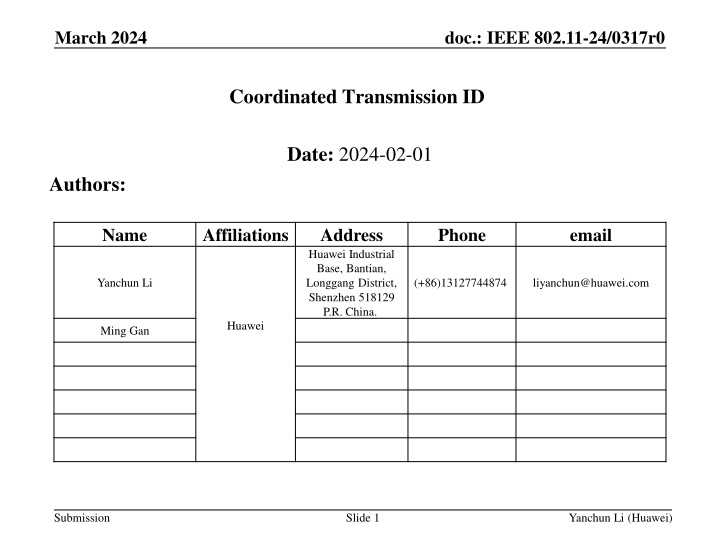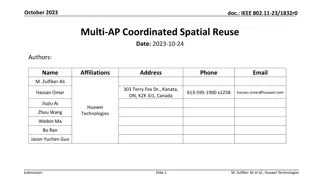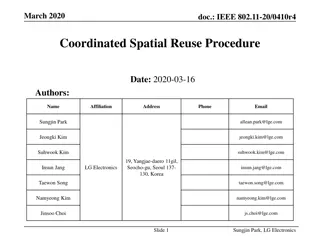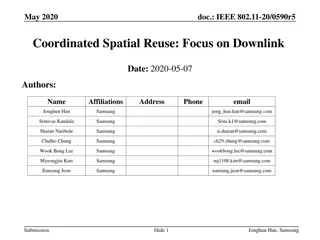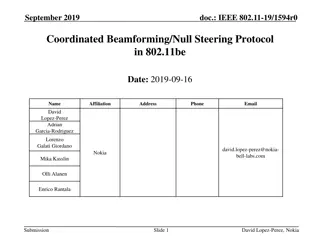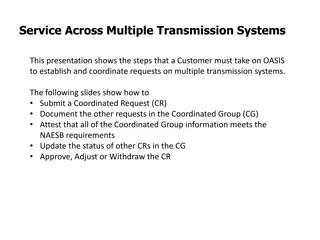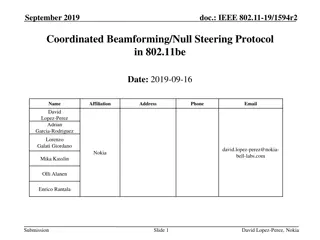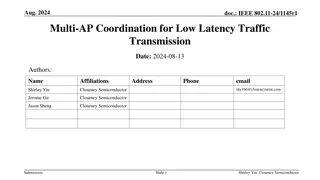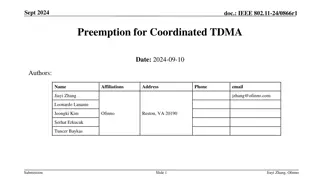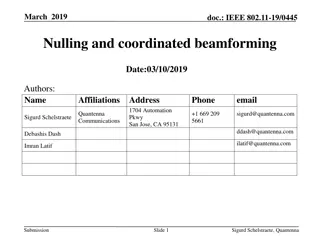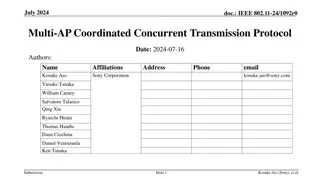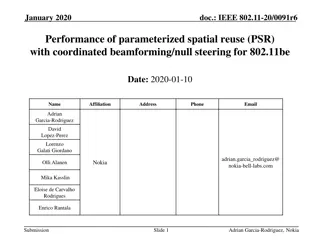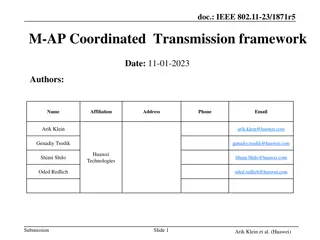IEEE 802.11-24/0317r0 Coordinated Transmission Issues
IEEE 802.11-24/0317r0 discusses challenges when coordinating transmissions from multiple APs, addressing BSS color collision detection, spatial reuse benefits, and the impact of BSS coloring in multi-AP settings.
Download Presentation

Please find below an Image/Link to download the presentation.
The content on the website is provided AS IS for your information and personal use only. It may not be sold, licensed, or shared on other websites without obtaining consent from the author.If you encounter any issues during the download, it is possible that the publisher has removed the file from their server.
You are allowed to download the files provided on this website for personal or commercial use, subject to the condition that they are used lawfully. All files are the property of their respective owners.
The content on the website is provided AS IS for your information and personal use only. It may not be sold, licensed, or shared on other websites without obtaining consent from the author.
E N D
Presentation Transcript
March 2024 doc.: IEEE 802.11-24/0317r0 Coordinated Transmission ID Date: 2024-02-01 Authors: Name Affiliations Address Huawei Industrial Base, Bantian, Longgang District, Shenzhen 518129 P.R. China. Phone email Yanchun Li (+86)13127744874 liyanchun@huawei.com Huawei Ming Gan Submission Slide 1 Yanchun Li (Huawei)
March 2024 doc.: IEEE 802.11-24/0317r0 Introduction BSS color has been introduced to IEEE 802.11 in 11ax. BSS color allows the PHY to infer the relevant BSS/source/destination of the PPDU If a home AP is not involved in any current transmission, the home AP or STA is able to reuse the channel. BSS color collision detection allows each of the nearby APs to have an unique BSS color locally. However, coordinated transmission such as JT, Coordinated BF, Coordinated OFDMA, etc, involves aligned transmission from multiple APs. It causes a problem over the air. This contribution discussed the problem. Submission Slide 2 Yanchun Li (Huawei)
March 2024 doc.: IEEE 802.11-24/0317r0 Recap BSS color in 802.11ax Usage of BSS color allows power saving at mobile STAs. Ignore irrelevant PPDU over air (if BSS color does not match). allows the efficient spatial reuse of spectrum (Fig. 1). AP1: AP2: (BSS color =B) (BSS color =A) STA1 STA2 Preamble (BSS color =A) Payload AP1: AP2: Payload Fig. 1 AP2 s BSS reuses spectrum after identifying transmission with BSS Color =A Submission Slide 3 Yanchun Li (Huawei)
March 2024 doc.: IEEE 802.11-24/0317r0 Recap multi-AP transmissions Considering that AP1 and AP2 serve STA1 and STA2, they transmit their preambles simultaneously on overlapping 20MHz channel(s). e.g. AP1: AP2: AP1: AP2: With nulling to suppress inter-BSS interference STA1 STA2 STA1 STA2 Case 1: Joint transmission Case 2: Coordinated BF Submission Slide 4 Yanchun Li (Huawei)
March 2024 doc.: IEEE 802.11-24/0317r0 When BSS coloring meets multi-AP transmissions BSS coloring in multi-AP transmission which allows spatial reuse can be beneficial for throughput, e.g. AP1: AP2: AP3: spatial reuse multi-AP transmission STA3 STA1 STA2 (1) AP1 and AP2 have coordinated BF/joint transmission etc. to STA1/2 with PPDU: Payload Preamble from AP1 and AP2 (2) STA2 hears Preamble from AP1 and AP2. It understands AP3 is idle and initiate EDCA uplink transmission to AP3. Submission Slide 5 Yanchun Li (Huawei)
March 2024 doc.: IEEE 802.11-24/0317r0 The issue when BSS coloring meets multi-AP transmissions For coordinated transmissions with multi-AP concurrent Tx: Case A: Each AP uses different BSS color leads to preamble collision. AP1: AP2: Assume AP1 uses BSS color A AP2 uses BSS color B STA1 STA2 Preamble NAV, BSS color =A, etc. These preambles have different waveform in U-SIG (due to BSS color difference). Payload AP1: L-LTF Preamble AP2: (adjacent to AP1) NAV, BSS color =B, etc. Payload L-LTF U-SIG L-LTFs are aligned, the estimated channel will be h1+h2, due to pilot contamination effect. However, the channel which AP1 s U-SIG signal pass through is not h1+h2 but h1, with superposed interference from AP2 (coded waveform with BSS color=B). The mismatch will dramatically increase PER for U-SIG. Submission Slide 6 Yanchun Li (Huawei)
March 2024 doc.: IEEE 802.11-24/0317r0 The issue when BSS coloring meets coordinated multi-AP transmissions (conti.) Case B: AP can also use BSS color =0, besides each AP s unique BSS color. However, it will disallow spatial reuse. Preamble (NAV, BSS color =0) Payload CCA busy It is important to allow successful transmission of BSS color and also indicate relevant BSS information clearly. Submission Slide 7 Yanchun Li (Huawei)
March 2024 doc.: IEEE 802.11-24/0317r0 Comparison of various coloring schemes Case A Case B Case C Case D Uncoordinated Transmission Schemes AP1: BSS color1 AP2: BSS color2 AP1: BSS color1 AP2: BSS color2 AP1: BSS color1+ partial bits(=1) in aid AP2: BSS color1+ partial bits(=2) in aid AP1: BSS color1 AP2: BSS color2 for 11bn STA for OBSS legacy STA Limit SR for legacy STA within AP1+2 Results Coordinated Transmission Schemes AP1: BSS color1 AP2: BSS color2 AP1+AP2: BSS color0 AP1+AP2: BSS color1+partial bits(=3) in aid AP1+AP2: BSS color3 X: legacy STA causes intra-BSS collision Results X X, disabled SR Submission Slide 8 Yanchun Li (Huawei)
March 2024 doc.: IEEE 802.11-24/0317r0 Summary We discussed the issue of BSS coloring for coordinated transmissions. A coloring scheme without ambiguity can allow coordinated multi-AP transmission while also allow spatial reuses. Submission Slide 9 Yanchun Li (Huawei)
March 2024 doc.: IEEE 802.11-24/0317r0 Straw Poll Do you agree that in 11bn should support to use UHR preamble for indicating of the APs involving multi-AP transmissions? Y N A Submission Slide 10 Yanchun Li (Huawei)
March 2024 doc.: IEEE 802.11-24/0317r0 References [1] https://mentor.ieee.org/802.11/dcn/22/11-22-1394-01- 0uhr-virtual-bss-and-multi-ap-transmissions.pptx Submission Slide 11 Yanchun Li (Huawei)
